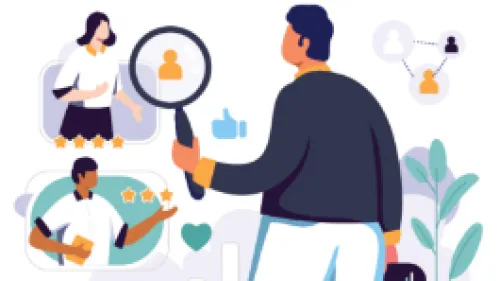
Planning your customer experience (CX) strategy is the first step for getting your new organization off the ground or continuing its success. By defining your CX goals and explaining how you will accomplish them, your organization can make every customer interaction meaningful and intentional.
The CX Toolkit provides guidance and templates to assist you in crafting an effective CX strategy tailored to your organizational goals. Kick-start your CX journey with confidence by first discovering who your customers are, and then uncovering their needs, preferences, and pain points.
Defining Your Customers
To develop a CX strategy, you need to first define your customers.
The Office of Management and Budget (OMB) defines customer as:
“Individuals, business, and organizations (such as grantees, state and municipal agencies) that interact with a Federal Government agency program, either directly or via a Federal contractor or a Federally-funded program.”
Simply put, we can describe our customers as those who serve (Government employees) and those we serve (the public).
| Those Who Serve | Those We Serve |
|---|---|
| Federal and other government employees | Travelers Applicants for Citizenship Boaters Disaster Survivors and many more |
Defining Your Desired Customer Outcomes
After you have defined a set of customers you can focus on their desired outcome. Ask yourself:
- What outcome do we want for the public?
- What experience do we want our customers to have?
Before seeking these answers, consider the following:
- Resources needed
- Personal approach
- Status as a sole CX practitioner
- Membership in a CX team
- Share these questions as a prompt:
- What outcome do we want for the public/our customers?
- What experience do we want our customers to have?
- Offer some quiet, heads-down time for the group to generate ideas.
- Have people share their ideas somewhere each other can see (ex: Mural, Word).
- For sharing the ideas, consider:
- A round of silent reading where people can mark ideas that stand out to them.
- Round-robin sharing where everyone gets to speak to what they wrote.
- Grouping ideas with similar themes and topics.
- For sparking discussion, consider:
- Asking people what ideas stand out to them or resonate most.
- Asking how the ideas presented align with established strategic priorities.
- Asking which ideas already have data and metrics supporting them.
- Align on which ideas resonate the most.
- Define possible next steps, which may include:
- Creating a draft outcome statement out of a combination of ideas.
- Mapping outcome ideas according to strategic priorities.
- Seeing which ideas are supported by user research (existing or planned).
- Sharing initial ideas for feedback from others who can help prioritize.
OMB A-11 recommends the following thematic areas that may offer inspiration for imagining and prioritizing customer outcomes.
- OMB Metric Themes
- Ease
- Effectiveness
- Emotion
- Trust
Customer outcomes or goals can be written in various ways, as long as they‘re:
- Clear
- Aspirational
- Specific
- Tangible
User Story
- You might write your customer outcome as a user story from the customer’s perspective.
- As a { customer type }, I want { action or resource } so that I can { outcome }.
- Here is an example goal written for customers of a fictitious ice cream store. As someone getting ice cream with my family, I want non-dairy options so that we can all enjoy our activity.
Future State Description
- You can also write your desired outcome as an aspirational description of a future state.
- { Customer type }, will { action or resource } so that { outcome }.
Here is another example from the ice cream store, using the format above:
- Families will have non-dairy options so that everyone can bond over our shared experience regardless of dietary restrictions.
Getting to “So That” and “So What”
- The examples above might seem simple, but people often stop at the “action or resource” step and omit the actual outcome. The customer outcome should reflect a tangible change in a customer’s experience because of your service. Challenge yourself to add “so that” to the end of your outcome statements or ask yourself, “So what?”
Identifying Your CX Metrics
Find and Partner with Data Experts
Find your data people and build relationships with them. Depending on your organization, they might sit in Performance, Evaluation, Solutions Development, and other areas. Perhaps your organization has a Strategy Lead or Chief Data Officer. Data skills, decision-making, and accountability are often spread out, along with the actual data. Think about finding and mapping out where your data experts are as part of your planning. This is important when setting up customer experience practices because having a clear understanding of your data and who handles it will help you make better decisions and improve your services.
Partner with data experts to explore, understand, and connect the data. Oftentimes, the data you think is there might not actually be there. Data may not be as clean or high-quality as you expect. Data scientists use a process called exploratory data analysis to help you:
- Make messy data more usable
- Make sense of the data
- Make connections in the data
This process is called exploratory data analysis. In the long run, you can create stronger CX data ecosystems by building relationships between:
- CX practitioners
- Data scientists
- Performance folks
- Monitoring and evaluation specialists


